Project aims to preserve Kenya's biodiversity
2017-06-14
The Chinese government, through the China-Africa Joint Research Centre - known as Sajorec - is committed to helping Kenya identify, review and document its plant diversity as part of an effort to develop strategies aimed at ecological services, conservation and sustainable use.
With the population growing and the search for a better life getting more attention, people are increasingly turning to native plants for raw materials, medical care, energy, fiber and food. So there's a need to understand and document the existing diversity of plants, according to Wang Qingfeng, Sajorec's director.
Toward that end, Sajorec, a collaboration between Kenya's Jomo Kenyatta University of Agriculture and Technology and the Chinese Academy of Sciences has entered into a partnership with the National Museum of Kenya on a project that aims to identify, review, document and conserve the country's botanical heritage, which is estimated at more than 240 vascular plant families.

Wang Qingfeng, director of China-Africa Joint Research Center. Provided to China Daily
"The collaboration will involve compiling the Kenyan flora and documenting, reviewing and monitoring plant species diversity," Wang says.
This is in addition to conserving threatened species and ecosystems and developing the capacity for systematic research.
Historical collections-more than a million specimen collections at the East African her barium-will be digitized and made available online. The biodiversity data of plant species accrued will be disseminated using various means to raise public awareness of species conservation.
At least three major joint field explorations are planned annually to cover the country, the key ones aimed at the coastal forests; the eastern arc mountains (Taita Hills); the dry lands ranging from Tsavo through Meru National Park; Garissa district; and Marsabit, Turkana and Pokot, including the Great Rift Valley (especially Maasai Mara); and Afromontane regions such as the Cherangani Hills.
"Unlike previous initiatives, the Kenyan flora will be published in color, with supporting maps and charts, both on paper and on the internet to facilitate wider access to the content," Wang says.
More than 100 scientists from China and Kenya will participate in the project through 10 years of comprehensive investigation of Kenyan flora.
There also will be references to existing files and documents, which will be reorganized.
Altogether, the conservation book Flora of Kenya will record about 7,000 to 8,000 species.
"Scientists have conducted six joint field investigations, and four new plant species have been published. The e-version - Flora of Kenya Online - is now available, while the first volume of the book will soon make its appearance," Wang says.
According to Geoffrey Mwachala of the National Museums of Kenya, the Flora of Kenya compilation is of great significance to basic scientific research and to the conservation of natural resources in Kenya and eastern Africa.
"The compilation is a good fit with the CAS international bureau's implementation of China's Going Global development strategy, which has involved foreign scientific and technological cooperation," Wang says.
The plan is to publish Flora of Kenya in 15 to 20 volumes, with each volume covering 400 to 500 plant species. The first volume will be published this year by Changjiang Publishing Media Group.
Kenya, which is in the tropical monsoon zone and has a diverse landscape and varied climate, has nearly 10,000 species of plants and forest coverage of up to 15 percent, according to Wang.
Inadequate biodiversity information has been a major impediment to conservation and sustainability in Kenya and the entire East African region, according to the National Museum of Kenya.
"With more than 1 million specimen collections preserved in the Botanical Garden and Herbarium, the botany department has a wealth of data awaiting discovery that can be of use in nation building," a report from the museum says. (China Daily)